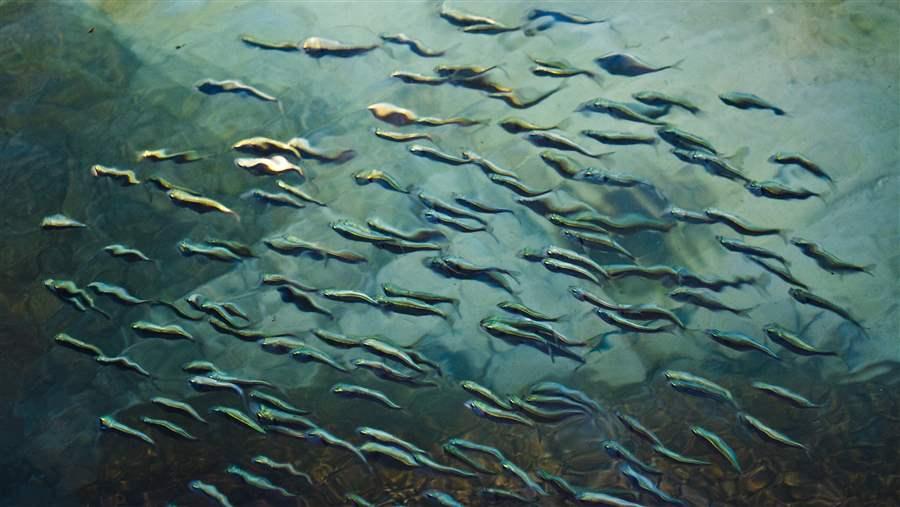Climate Cycle Found To Drive Menhaden Reproductive Success
 © Getty Images
© Getty ImagesMenhaden feeding. New research shows the reproductive success of this forage fish responds to a natural climate cycle.
Scientists have long puzzled over what drives the reproductive success of Atlantic menhaden, a tiny but critical East Coast fish. A new study provides a partial answer: an oceanic climate cycle known as the Atlantic Multidecadal Oscillation, or AMO. The finding is likely to be useful in improving the way scientists assess the species and the way managers set catch limits.
Menhaden is a small, oily fish that provides food for striped bass, bluefish, and several other species, as well as bait for fishermen. It also is the target of the largest fishery on the East Coast, which is centered in Virginia and catches menhaden for use in nutritional supplements, animal feed, and fertilizer. Setting catch limits has proved challenging, in part because no one has been able to say what drives recruitment—a technical term for how many young fish are produced. Recruitment largely determines how much fishing a population can sustain.
“Predicting recruitment for menhaden is like shooting fish in a barrel, but the barrel turns out to be very far away and you have to close your eyes before firing,” said Tom Miller of the University of Maryland, an author of the study. “It is very frustrating to try and understand and manage this stock.”
To address this, the researchers used a statistical model designed for disorderly data like those on the abundance of young menhaden. They considered 16 factors that might be driving that abundance, including climatic cycles, intensity of fishing, temperature, salinity, and predator abundance.
They found that the most important driver of recruitment is the AMO. In this natural cycle, average sea surface temperature shifts by about one degree Fahrenheit (0.56 degrees Celsius) every 20 to 40 years across most of the north Atlantic.
The effect of the AMO on menhaden is different in different places. South of Cape May, New Jersey, the warm phase of the AMO, which has been in effect since the 1990s, is generally associated with menhaden recruitment being lower than average. North of Cape May, the warm phase is associated with higher than average recruitment. It is not yet clear why the AMO has this effect, but it could be exerting its influence through water temperatures or through the currents needed to transport menhaden eggs and larvae into suitable nursery habitat.
The finding suggests that current management, which does not directly consider environmental drivers, could result in unsustainable catch limits in bad recruitment years and unnecessarily stringent limits in good years.
“There is a surprisingly clear climatic effect,” said Andre Buchheister, the study’s lead author and a fisheries biologist at Humboldt State University in California. “We see a number of ways to incorporate this into the process for setting catch limits that match the rate at which the stock can replace itself. For example, the AMO could simply be used as an indicator for when to reduce target fishing mortality.”
Managers of the menhaden fishery are already considering ways to incorporate climate cycles and other ecosystem factors. The authors of this study plan to work with them to build on this progress. Similar research on other forage fish species could also help improve management of other fisheries.
Two other findings are relevant to management:
- The study did not detect a correlation between recruitment and the number of eggs produced by menhaden. This suggests the current use of egg count as the main indicator of how many fish will be produced is insufficient. The study suggests, however, that the size and/or age structure of the adult population may be an important factor in understanding the extreme variation in how many young fish are produced each year.
- It also did not detect a negative effect of fisheries landings on recruitment. However, it would be wrong to conclude that high catches are therefore sustainable. One of the few “laws” of biology is that parents are needed to produce offspring. The relationship between adult abundance and recruitment has been shown definitively many times, including by the late Ram Myers, who assembled data on adult abundances and recruitment for fish stocks from all over the world.
The study was published in the ICES Journal of Marine Science and supported by the Lenfest Ocean Program.

